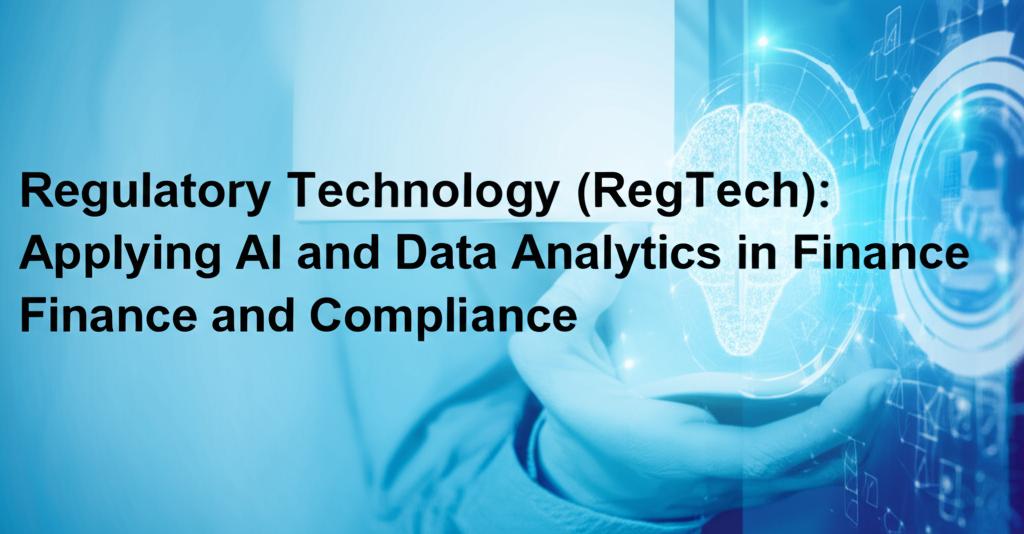The landscape of finance and compliance is navigating an era of unprecedented complexity. Ever-evolving regulations, the sheer volume of data, and the constant pressure to operate efficiently while mitigating risk demand innovative solutions. Regulatory Technology (RegTech), particularly when powered by Artificial Intelligence (AI) and advanced data analytics, is stepping up to meet these challenges, transforming how financial institutions manage their regulatory obligations.
The Synergy of AI, Data Analytics, and ComplianceRegTech leverages technologies like AI, machine learning (ML), and big data analytics to help businesses comply with regulations more efficiently and effectively. Instead of relying solely on manual processes, which are often slow, costly, and prone to error, AI-driven RegTech offers automation, deeper insights, and proactive capabilities.
Transforming Key Compliance Functions:AI and data analytics are being applied across various compliance functions with significant impact:
- Automated Regulatory Monitoring and Reporting: AI systems, particularly those using Natural Language Processing (NLP), can scan and interpret vast amounts of regulatory text, identifying changes and relevant requirements in real-time. This allows firms to stay updated with less manual effort. Furthermore, AI automates the collection, consolidation, and formatting of data for regulatory reports, reducing errors, saving time, and ensuring timely submissions. Structured data formats enhance report accuracy and transparency.
- Enhanced Risk Management and Detection: AI algorithms excel at analyzing massive datasets to identify patterns, anomalies, and potential risks that humans might miss. This includes detecting suspicious activities related to anti-money laundering (AML), fraud, and terrorist financing. Predictive analytics can forecast potential compliance breaches or emerging risks, allowing institutions to take proactive mitigation steps.
- Streamlined KYC and Customer Due Diligence: AI automates aspects of Know Your Customer (KYC) and customer due diligence processes, from identity verification using biometrics to ongoing monitoring of customer activity and risk profiling. This speeds up client onboarding and ensures continuous compliance checks.
- Real-Time Transaction Monitoring: AI enables continuous, real-time monitoring of transactions to flag suspicious activities instantly, moving beyond traditional, often retrospective, rule-based systems. This leads to faster responses to potential threats and reduces false positives often associated with older systems.
- Intelligent Document Processing: Technologies like Intelligent Document Processing (IDP) use AI to extract and analyze information from various document formats (structured and unstructured), automating data entry and verification, which is crucial for compliance tasks involving large amounts of paperwork.
The integration of AI and data analytics into RegTech offers substantial advantages:
- Increased Efficiency and Cost Reduction: Automating repetitive, manual tasks frees up compliance professionals for more strategic work, speeds up processes, and significantly lowers operational costs associated with compliance.
- Improved Accuracy and Reduced Errors: Automation minimizes human errors in data handling and reporting, leading to higher quality compliance outcomes.
- Enhanced Risk Mitigation: Proactive risk identification and real-time monitoring capabilities allow institutions to address potential issues before they escalate, reducing the likelihood of fines and reputational damage.
- Better Decision-Making: Data analytics provide deeper insights into compliance performance and risk patterns, supporting more informed strategic decisions.
- Scalability: AI-driven solutions can handle increasing data volumes and regulatory complexity more effectively than manual approaches.
- Adaptability: AI systems can be updated more quickly to adapt to the constantly changing regulatory landscape.
The role of AI in RegTech is set to expand further:
- AI Moving Mainstream: 2025 is predicted to be the year AI transitions from hype to tangible, embedded solutions within compliance workflows, delivering measurable value.
- Generative AI Exploration: More firms are expected to pilot and deploy Generative AI for tasks like summarizing regulations or drafting initial compliance reports, though regulatory scrutiny remains.
- Cloud-Based Solutions: The adoption of scalable and flexible cloud-based RegTech platforms (RegTech-as-a-Service or RaaS) will likely accelerate.
- Focus on Data Privacy and Security: With stricter data protection laws globally (like GDPR), RegTech solutions incorporating advanced encryption and monitoring tools are becoming crucial.
- Real-Time Capabilities as Standard: Real-time monitoring and reporting are becoming baseline expectations rather than advanced features.
- ESG Integration: There's a growing demand for RegTech tools that help firms manage and report on Environmental, Social, and Governance (ESG) compliance requirements.
- Increased Collaboration: Expect greater collaboration between financial institutions, technology providers, and regulators to foster innovation and navigate challenges.
Despite the benefits, adopting AI in RegTech is not without hurdles:
- Integration Complexity: Integrating new RegTech solutions with existing legacy systems can be technically challenging and costly.
- Data Quality and Privacy: AI models require vast amounts of high-quality data, raising concerns about data sourcing, management, security, and compliance with privacy regulations.
- Transparency and Explainability: The "black box" nature of some AI models can make it difficult to understand how decisions are made, which is problematic for audits and regulatory scrutiny.
- Talent Gap: There's a need for professionals with expertise in both compliance and data science/AI to implement and manage these technologies effectively.
- Ethical Concerns and Bias: Ensuring AI systems are fair, unbiased, and used ethically is paramount.
- Regulatory Uncertainty: Regulators are still developing frameworks for overseeing the use of AI, creating some uncertainty for adopting institutions.
AI and data analytics are no longer optional add-ons but essential components of modern regulatory compliance in the financial sector. By automating processes, enhancing analytical capabilities, providing real-time insights, and enabling proactive risk management, these technologies empower organizations to navigate the complex regulatory environment more efficiently and effectively. While challenges related to implementation, data, ethics, and transparency remain, the trajectory is clear: AI-powered RegTech is fundamental to building resilient, compliant, and future-ready financial institutions.

